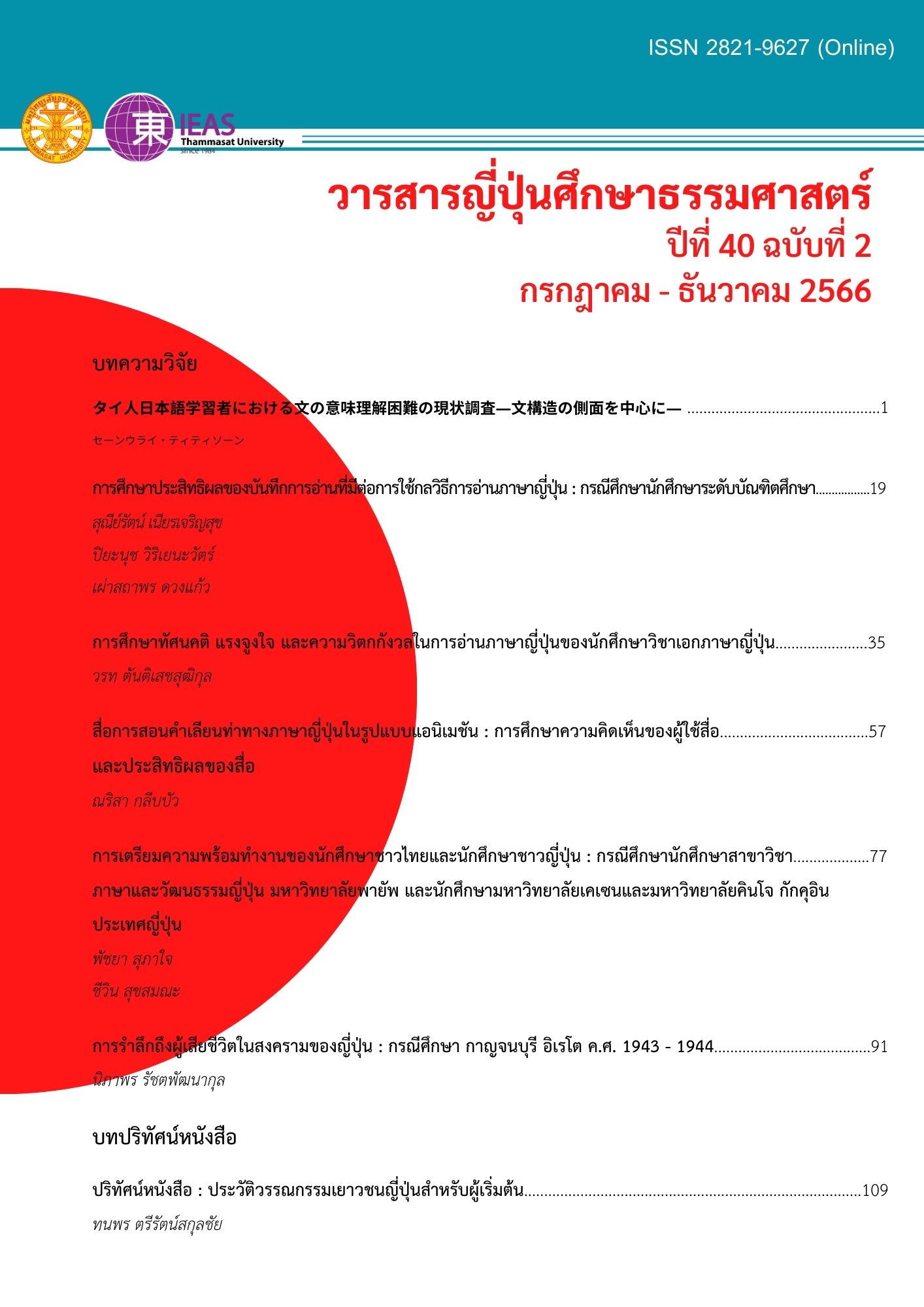การศึกษาประสิทธิผลของบันทึกการอ่านที่มีต่อการใช้กลวิธีการอ่านภาษาญี่ปุ่น : กรณีศึกษานักศึกษาระดับบัณฑิตศึกษา
คำสำคัญ:
บันทึกการอ่าน, กลวิธีการอ่าน, การอ่านภาษาญี่ปุ่น, นักศึกษาระดับบัณฑิตศึกษาบทคัดย่อ
งานวิจัยนี้มีวัตถุประสงค์เพื่อศึกษาประสิทธิผลของบันทึกการอ่านที่มีต่อการใช้กลวิธีการอ่านภาษาญี่ปุ่นโดยการเปรียบเทียบความเปลี่ยนแปลงก่อนทำบันทึกการอ่านและหลังทำบันทึกการอ่านเป็นเวลาหนึ่งภาคการศึกษา กลุ่มตัวอย่างคือนักศึกษาระดับบัณฑิตศึกษาสาขาวิชาญี่ปุ่นศึกษา มหาวิทยาลัยธรรมศาสตร์ จำนวน 3 คน แบบสอบถามกลวิธีการอ่านที่ใช้ในงานวิจัยนี้ปรับจากแบบสอบถามของ Kouider Mokhtari และ Ravi Sheorey
ผลการศึกษาพบว่าในภาพรวมก่อนการทำบันทึกการอ่าน นักศึกษาใช้กลวิธีการอ่านในระดับมาก โดยใช้กลวิธีประเภทแก้ปัญหามากที่สุด หลังจากทำบันทึกการอ่าน นักศึกษาใช้กลวิธีการอ่านในระดับมากโดยค่าเฉลี่ยเพิ่มขึ้นจาก 3.95 เป็น 4.09 เมื่อพิจารณาแยกตามประเภทของกลวิธีพบว่าผู้เรียนใช้กลวิธีประเภทองค์รวม และการสนับสนุนการอ่านเพิ่มขึ้น ประเภทองค์รวม ข้อที่มีค่าเฉลี่ยเพิ่มขึ้นมากที่สุดคือ “ฉันจะอ่านเนื้อหาคร่าว ๆ โดยรวมทั้งหมดว่าเกี่ยวกับอะไรก่อนที่จะอ่านแบบละเอียดต่อไป” ประเภทการสนับสนุนการอ่าน ข้อที่มีค่าเฉลี่ยเพิ่มขึ้นมากที่สุดคือ “ฉันมักจะอ่านสลับไปมาทั้งตอนต้นและตอนท้ายเพื่อหาความเชื่อมโยงของเนื้อหา” ผลดังกล่าวแสดงให้เห็นว่าบันทึกการอ่านช่วยทำให้ผู้เรียนสามารถวางแผนก่อนการอ่านและส่งเสริมการตรวจสอบความเข้าใจระหว่างการอ่านให้มากขึ้น ซึ่งจะเชื่อมโยงไปสู่การอ่านที่มีประสิทธิภาพเพิ่มขึ้น
Downloads
เอกสารอ้างอิง
จิรารัตน์ ประยูรวงษ์. (2565). การศึกษาการตระหนักรู้และการใช้กลวิธีการกำกับตนเองในการอ่านภาษาอังกฤษเชิงวิชาการของนักศึกษาชั้นปีที่ 2 และปีที่ 3 มหาวิทยาลัยราชภัฏวไลยอลงกรณ์ ในพระบรมราชูปถัมภ์. วารสารวไลยอลงกรณ์ปริทัศน์ (มนุษยศาสตร์และสังคมศาสตร์), 12(1), 76-94.
เตวิช เสวตไอยาราม. (2559). กลวิธีการอ่านของผู้เรียนภาษาญี่ปุ่นชาวไทยที่มีความสามารถต่างกัน. วารสารญี่ปุ่นศึกษาธรรมศาสตร์, 33(2), 59-78.
วิภาดา พูลศักดิ์วรสาร และ วิสาข์ จัติวัตร์. (2556). การพัฒนารูปแบบการสอนอ่านเน้นภาระงานโดยใช้กลวิธีอภิปัญญาสำหรับผู้ใหญ่เพื่อส่งเสริมความเข้าใจในการอ่านภาษาอังกฤษ. วารสารศิลปากรศึกษาศาสตร์วิจัย, 5(2), 151-166.
สรณบดินทร์ ประสารทรัพย์. (2562). ผลของการสอนกลวิธีการอ่านอภิปัญญาที่มีต่อการอ่านเพื่อความเข้าใจและตระหนักรู้ในการใช้กลวิธีการอ่านของนักเรียนระดับชั้นมัธยมศึกษาปีที่ 4. วารสารศึกษาศาสตร์ มหาวิทยาลัยศิลปากร, 16(1), 104-119.
สาริศา ไม่หวาด และ สุมาลี ชิโนกุล. (2561). ผลของการใช้กลวิธีการอ่านของนิสิตนักศึกษาระดับบัณฑิตศึกษาไทยและต่างชาติที่มีผลต่อความเข้าใจการอ่าน. วารสารอิเล็กทรอนิกส์ทางการศึกษา, 12(4), 314-332.
สุณีย์รัตน์ เนียรเจริญสุข. (2561). ประสิทธิผลของกิจกรรมการอ่านร่วมกันกับเพื่อนในวิชาการอ่านภาษาญี่ปุ่น.วารสารญี่ปุ่นศึกษาธรรมศาสตร์, 35(2), 68-81.
อูมัยซี รักษ์อาณา และ อดิศา เตียว. (2559). ผลของการใช้แบบบันทึกการอ่านต่อการอ่านเพื่อความเข้าใจของนักเรียนชั้นมัธยมศึกษาปีที่ 5 ในจังหวัดตรัง. ใน การสัมมนาเครือข่ายนักศึกษาระดับบัณฑิตศึกษา สาขาสังคมวิทยาและมานุษยวิทยา ครั้งที่ 16 ประจำปีการศึกษา 2559 (น. 101-120). คณะสังคมศาสตร์ มหาวิทยาลัยนเรศวร.
Homan, Y. (2011). Improving reading courses at Japanese universities: from “Yakudoku” to “Reading Strategies” and “Extensive Reading”. The Quarterly journal of Rissho Economics Society, 60(2), 93-107.
Mokhtari, K. & Sheorey, R. (2002). Measuring ELS students’ awareness of reading strategies. Journal of Developmental Education, 25(3), 2-10.
Saito, Y., Horwitz, E., & Garza, T. (1999). Foreign language reading anxiety. The Modern Language Journal, 83(2), 202-218.
荒川歩、安田裕子、サトウタツヤ. (2012). 「複線径路・等至性モデルのTEM図の描き方の一例」. 『立命館人間科学研究』, 25,95-107.
甲田直美. (2009). 『文章を理解するとは—認知の仕組みから読解教育への応用まで』. スリーエーネットワーク.
サグアンシー・タンヤーラット. (2016). 「外国語としての日本語における読解不安・外国語学習不安・読解力との関係 : タイ人大学生を対象に」. 『言語科学研究 : 神田外語大学大学院紀要 』, 22, 45-64.
サトウ・タツヤ. (2009). 『TEMで始める質的研究:時間とプロセスを扱う研究をめざして』. 誠信書房.
福本和佳子、印道緑. (2016). 「文脈力をつける読解教育」. 『北九州市立大学国際論集』, 14, 157-170.
羅曉勤.(2010). 「中級読解授業でピア・ラーニングの有効性について―台湾人日本語学習者の視点から―」.『台灣日本語文學報』, 28, 335-357.
ดาวน์โหลด
เผยแพร่แล้ว
ฉบับ
ประเภทบทความ
สัญญาอนุญาต
ลิขสิทธิ์ (c) 2023 วารสารญี่ปุ่นศึกษาธรรมศาสตร์

อนุญาตภายใต้เงื่อนไข Creative Commons Attribution-NonCommercial-NoDerivatives 4.0 International License.




